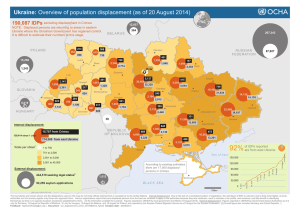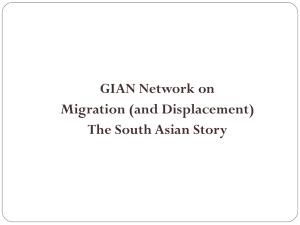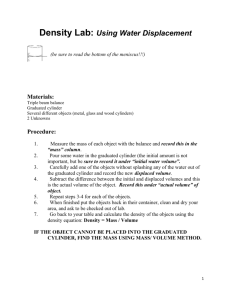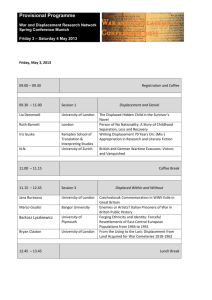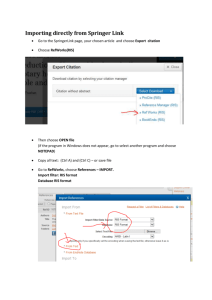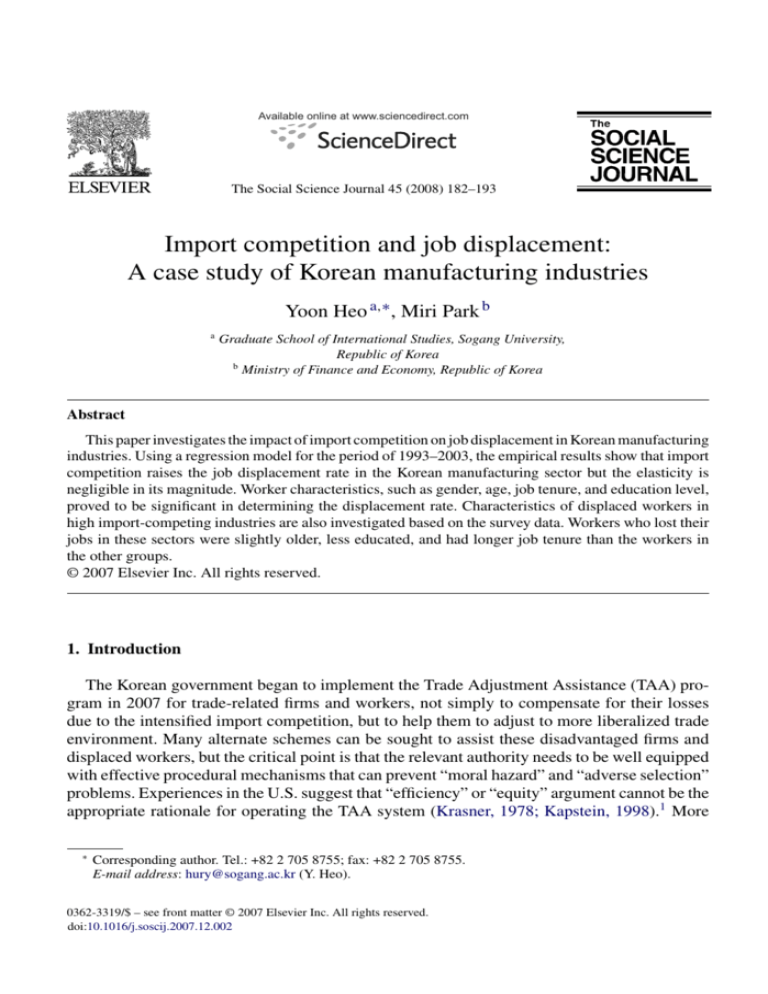
Available online at www.sciencedirect.com
The Social Science Journal 45 (2008) 182–193
Import competition and job displacement:
A case study of Korean manufacturing industries
Yoon Heo a,∗ , Miri Park b
a
Graduate School of International Studies, Sogang University,
Republic of Korea
b
Ministry of Finance and Economy, Republic of Korea
Abstract
This paper investigates the impact of import competition on job displacement in Korean manufacturing
industries. Using a regression model for the period of 1993–2003, the empirical results show that import
competition raises the job displacement rate in the Korean manufacturing sector but the elasticity is
negligible in its magnitude. Worker characteristics, such as gender, age, job tenure, and education level,
proved to be significant in determining the displacement rate. Characteristics of displaced workers in
high import-competing industries are also investigated based on the survey data. Workers who lost their
jobs in these sectors were slightly older, less educated, and had longer job tenure than the workers in
the other groups.
© 2007 Elsevier Inc. All rights reserved.
1. Introduction
The Korean government began to implement the Trade Adjustment Assistance (TAA) program in 2007 for trade-related firms and workers, not simply to compensate for their losses
due to the intensified import competition, but to help them to adjust to more liberalized trade
environment. Many alternate schemes can be sought to assist these disadvantaged firms and
displaced workers, but the critical point is that the relevant authority needs to be well equipped
with effective procedural mechanisms that can prevent “moral hazard” and “adverse selection”
problems. Experiences in the U.S. suggest that “efficiency” or “equity” argument cannot be the
appropriate rationale for operating the TAA system (Krasner, 1978; Kapstein, 1998).1 More
∗
Corresponding author. Tel.: +82 2 705 8755; fax: +82 2 705 8755.
E-mail address: hury@sogang.ac.kr (Y. Heo).
0362-3319/$ – see front matter © 2007 Elsevier Inc. All rights reserved.
doi:10.1016/j.soscij.2007.12.002
Y. Heo, M. Park / The Social Science Journal 45 (2008) 182–193
183
weight is given to the “political usefulness” of buying the favor of those who are disadvantaged by free trade and facilitating progress towards a freer trade regime. Consequently, a
systematic accumulation of relevant evidence and an efficient sharing of information among
government bodies and the other agencies involved have also become imminent tasks for the
Korean government to fulfill.2
This study investigates the relationship between import competition and job displacement
in Korean manufacturing industries. The focus of this study is on four key questions: (1) Does
increasing import competition in manufacturing industries have a significant influence on job
displacement? (2) Do displaced workers in high import-competing industries have any special
characteristics? (3) Are there any unique traits of displaced workers in Korean manufacturing
industries compared to those in other groups or displaced workers in manufacturing industries
in the U.S.? (4) If any, then, should policy makers establish measures or alter existing measures
to assist losers?
2. Theoretical framework
For many decades, the “free trade” debate in the public policy arena has emphasized the
overall benefits accruing to society from trade. This one-sided emphasis has been halted by
the globalization backlash. Regarding the side effects of free trade in terms of the interests
of losers and job security issues, in order to figure out what policy failures are in reality,
Kletzer (2001) defines import-competing job loss in the U.S. and compares import-competing
displaced workers’ characteristics to those of other displaced workers. She finds a relationship
between import competition and job displacement in sectors identified as import sensitive, but
not for other sectors.
While Kletzer (2001, 2002a, 2002b) gives weight to import-competing displaced workers’
characteristics and social aid for them, Clark, Herzog, and Schlottman (1998) examine the correlation between import competition and employment risk using the data of displaced workers
certified by the Trade Adjustment Assistance program in the U.S.. Clark et al. (1998) focus
more on job-search outcomes of trade-related displaced workers and the change in their wages,
finding wage depression as well as employment risk arises from import competition. In order
to provide insights into the dispute over special compensations for trade displaced workers,
they investigate whether trade-related displaced workers are at disadvantage during their job
searches vis-à-vis comparable workers displaced for other reasons. They observe that TAA
recipients are not at a disadvantage during the job-search and relocation process. Workers’
personal characteristics, rather than import competition, affect job displacement more greatly.
Marcal (2001) also shows that the TAA program hardly increases the subsequent wages of
its participants over comparable unemployment insurance (UI) exhaustees. These findings are
consistent with other earlier studies by Grossman (1987), Freeman and Katz (1991), Gaston
and Trefler (1997), and Revenga (1992), in that these researchers also conclude that domestic
factors are much more important drivers of job losses in the developed countries.
Prior to Clark et al. (1998), Neumann (1979) reports that workers whose job losses resulted
from import competition are at a disadvantage vis-à-vis other unemployed workers and that
TAA recipients are older, less educated or unskilled, and have a greater portion of their work
184
Y. Heo, M. Park / The Social Science Journal 45 (2008) 182–193
experience with a single firm than other unemployed workers. Leonard (1987) verifies the
loophole of Neumann’s study and shows that workers displaced from import competition suffer
no extraordinary hardships during the job search. He concludes that retraining programs, jobsearch aids, and extended unemployment benefits for the trade-related job displaced could
induce opposition from workers displaced for other reasons. Kletzer (2001, 2002a, 2002b),
Clark et al. (1998) and Leonard (1987) unanimously report that TAA programs, especially
extended unemployment benefits, cause policy holders to be negligent in searching for jobs
after their displacement.
After surveying the substantial literature on the links between trade and labor market outcomes, Hoekman and Winters (2005) conclude that empirical results regarding the impact of
trade on sectoral employment in developed countries are mixed, but also find that the general
consensus is that the net employment effects of trade are negligible.
3. Import-competing industry and its displacement rate
3.1. Methods and data
Job displacement can be represented as:
D = f (I, Z)
where D represents the displacement rate, and I is an industry measure of import competition,
and Z is a vector of other determinants. More specifically, the regression equation can be set
out as:
Dit = α · IPit + β · Zit + θi,t
where Dit represents the displacement rate of industry i in the year t, IPit represents the
increasing rate of import share with industry i in the year t (import penetration rate of industry
i), and Zit is a vector of other determinants with industry i in the year t, and θ i,t is the unobserved
variant. Here, the job displacement rate is different from the simple unemployment rate we
observe. The number of displaced workers was obtained by subtracting the number of workers
who quit their jobs voluntarily or who took up other employment from the total workers who
lost their jobs in each industry in the year. Then, the job displacement rate is calculated by
dividing the headcount of these displaced workers by the total number of employees in each
industry. Import penetration rate is the growth rate of import share. Import(export) share is the
ratio of import(export) amount over the total amount of sales in industry i.
The trade-flow data were obtained from the Korea International Trade Association (KITA)
and the Korea National Statistical Office, which operates the Korea Statistical Information
System (KOSIS). Data on imports and exports are available for manufacturing industries,
defined by the detailed, 3-digit Standard International Trade Classification (SITC). However,
those data are again adjusted to 2-digit Standard Korean Trade Classification (SKTC 15-37)
in order to show the consistency with other data such as unemployment rate, head counts of
Y. Heo, M. Park / The Social Science Journal 45 (2008) 182–193
185
displaced workers, and employees’ education level in each sector that are only provided with
2-digit SKTC.
Data from 1993 to 2003, excluding 1998, are examined. Year 1998, which was the year of
the foreign currency crisis in Korea, was excluded because all the data in this year shows a very
different pattern from the other years and it might distort the analysis as an outlier.3 Data related
to displaced workers’ characteristics such as age, education level, gender, and job tenure in the
manufacturing industries are literally unobtainable because the Korean government does not
officially accumulate and provide it. Consequently, data from the worker survey done by the
Korea Labor Institute and the Labor Statistics from the Ministry of Labor were gathered and
used as an alternate data set in the analysis.
3.2. Definition of an import-competing industry
It is broadly accepted that the definition of an import-competing industry is one with a high
import penetration rate. In this study, changes in import share are used to measure the degree
of import penetration. Twenty industries in manufacturing are classified into three levels of
import competition: high, medium, and low. The top six industries have had an annual increase
of import share of 20% or more. These six industries, 33% out of twenty industries, are
categorized as a high import-competing group. Table 1 lists the high, medium, and low importcompeting industries. The top six industries are likely to produce more displaced workers
from import competition. For each industry, Table 1 reports, from left to right, the total number
of displaced workers, average displacement rate, changes in import share, number of total
displaced workers, the percentage of female workers, average age, average job tenure, education
level, and the intra-industry trade pattern with the Grubel-Lloyd index in parentheses. As can
be observed in Table 1, all six industries in the high import-competing group are importers.
Five industries with relatively moderate changes in import share (annual average of 10% or
more) are classified as “medium” import competing, and nine industries are classified as “low”
import competing.
The different characteristics of the various industries bring up other challenging questions:
How greatly does an increase in changes of import share have an impact on the job displacement
rate? How different is the relationship between import penetration and the displacement rate
among the high, medium, and low import-competing groups of industries?
3.3. The relationship between import competition and job displacement
Table 2 shows how manufacturing job displacement is affected by changes in import share,
changes in export share, and other relevant variables such as average wage, the percentage of
female workers, workers’ average age, workers’ average job tenure, and the percentage with
less than a high school graduation, respectively. Using all the data logged, model 1 excludes
“changes in export share” and the “average wage” from the explanatory variables, and model
2 estimates the determinants of the displacement rate without omitting any variables.
The dependent variable, the displacement rate, is positively correlated with changes in import
share in manufacturing. One percent acceleration of the import share growth rate is combined
with roughly 0.002–0.003% change in the job displacement rate. The two models both show
186
Y. Heo, M. Park / The Social Science Journal 45 (2008) 182–193
Table 1
Characteristics of current employees in Korean manufacturing industries 1993–2003 (1998 excluded)
Industry
High import competing
Medical, precision and optical
instruments, watches and clocks
Machinery and equipment
Radio, TV and communication
equipment and apparatus
Wood and cork products except
furniture
Furniture; manufacturing
Basic metals
Medium import competing
Tanning and dressing of leather:
luggage, handbags, harness and
footwear
Electrical machinery and apparatus
Textiles
Rubber and plastics products
Wearing apparel and fur articles
Low import competing
Chemicals and chemical products
Fabricated metal products except
machinery and equipment
Other nonmetallic mineral products
Tobacco
Publishing, printing and reproduction
of recorded media
Motor vehicles, trailers and
semitrailers
Peripheral units of computer and
other office appliances
Pulp, paper and paper products
Beverages
Characteristics
TNDW
AADR
AGIS
FEM
AGE
TENU
EDU
IITP
10,004
0.0294
0.742
0.435
32.82
4.29
0.408
UI
58,768
64,376
0.0225
0.0251
0.453
0.315
0.208
0.543
34.71
30.31
5.54
4.72
0.444
0.393
BI
BI
6,475
0.0283
0.241
0.257
40.44
4.63
0.536
UI
19,984
14,777
0.0261
0.0243
0.215
0.215
0.379
0.163
36.54
38.08
4.58
8.31
0.482
0.547
UI
BI
20,384
0.0260
0.180
0.475
38.52
4.01
0.555
UE
31,604
61,591
34,103
43,708
0.0259
0.0281
0.0264
0.0330
0.178
0.156
0.125
0.124
0.400
0.512
0.320
0.709
34.18
35.52
35.95
36.03
5.12
4.34
4.88
3.29
0.446
0.585
0.478
0.510
BI
UE
UE
UI
23,387
44,854
0.0142
0.0285
0.102
0.091
0.370
0.230
34.63
36.80
6.85
4.57
0.363
0.498
BE
BE
23,464
455
18,930
0.0230
0.0121
0.0230
0.086
0.084
0.067
0.253
0.318
0.406
37.52
44.54
34.59
5.85
18.04
4.61
0.440
0.627
0.226
UI
UI
BE
31,497
0.0164
0.038
0.203
34.26
6.46
0.544
UE
9,768
0.0213
0.030
0.455
30.34
4.06
0.383
UE
11,775
35,592
0.0203
0.0225
0.023
0.006
0.263
0.547
37.52
38.00
6.30
5.72
0.483
0.421
BE
BI
TNDW: Total number of displaced workers (1993–2003); AADR: annual average of job displacement rate, AGIS:
annual average growth rate of import share; FEM: annual average percentage of female workers; AGE: annual
average age of workers; TENU: annual average length of job tenure; EDU: average percentage of workers with less
than a high school education; UI: unbalanced importer; BI: balanced importer; UE: unbalanced exporter; and BE:
balanced exporter (based on the Grubel-Lloyd index we calculated).
that import penetration has a positive and statistically significant impact on the displacement
rate at 0.01. However, the import penetration elasticity of job displacement is ignorable in its
magnitude. Interesting enough, changes in export share, which are the amount of export over
the total value of production in industry i, influence the displacement rate negatively, implying
that export promotion contributes to a reduction in job displacement.
Consistent with other studies including Hoekman and Winters (2005), we find no single
cause of import penetration, but a plurality of factors accounting for the job displacement in
Korea. Workers’ average age and job tenure have a significant influence on the displacement
Y. Heo, M. Park / The Social Science Journal 45 (2008) 182–193
187
Table 2
Determinants of job displacement in Korean manufacturing industries
Variable
Models
1
Import penetration
Changes in export share
Average wage
Worker characteristics
Share of female workers
Average age
Average job tenure
Education
Share with less than a high school graduate education
r2
F statistic
Durbin-Watson Stat
∗
∗∗
2
*
0.0024 (1.9604)
0.0032* (1.8520)
−0.0017* (−2.0065)
−.0.0012 (−1.4466)
0.0461* (2.2084)
0.0117** (13.8606)
−0.0142** (−10.8543)
0.0423* (1.8503)
0.0169** (4.9390)
−0.0143** (−11.3964)
0.0013** (3.0970)
0.0010** (2.3333)
0.83
71.58
1.99
0.85
52.71
1.89
t test significant at the 0.05 level.
t test significant at the 0.01 level.
rate at 0.01 level, and the percentage of female workers at 0.05 level. Relatively less educated
laborers, captured as “the percentage with less than a high school graduate education” are more
vulnerable to job displacement. Higher percentages of female workers and older workers can
raise the job displacement rate in the corresponding industries. Workers’ average job tenure
affects the displacement rate negatively, which is different from in the U.S.. In case of the U.S.
manufacturing industry, job tenure has a positive influence on the displacement rate. Workers
who stayed in their jobs for relatively longer periods tended to lose their jobs more easily
(Kletzer, 2001, 2002a, 2002b). This difference in the sign of the coefficient on job tenure in
Korea and the U.S. can stem from the fact that industry averages are used for this study, while
individuals level data were used for the U.S.. The job tenure data used in our study is also
for currently employed workers, while the data for the U.S. are derived from a survey about
displaced workers. Another way to interpret the negative relationship between job tenure and
job displacement in Korea is that longer tenure implies workers may lack transferable human
capital and hence forced to stay at the current job even at the risk of being displaced. Also,
compared with the U.S., Korean manufacturing industries are relatively more concentrated
in large urban areas where alternate employment is more abundant. In the case of Korea, a
consistent data set for displaced workers is unattainable. If we could somehow use the data set
from the survey of displaced workers for the estimation of the regression equation, the result
could be reversible (see Table 4).
Table 3 reports the impact on workers’ job displacement rate, respectively, in terms of the
degree of import competition. The results for the top six industries in the high import-competing
group show that workers in this group are impacted by changes in import share, an outcome that
is similar to the results for the low import-competing group. High import-competing industries
show the same pattern as manufacturing industries as a whole with respect to the impact on
the displacement rate of changes in export share, the percentage of female workers, workers’
education level, workers’ average age, and their average job tenure.
188
Y. Heo, M. Park / The Social Science Journal 45 (2008) 182–193
Table 3
Determinants of job displacement with different groups of industries in Korea
Variable
Groups
High
Import penetration
Changes in export share
Average wage
Worker characteristics
Share of female workers
Average age
Average job tenure
Education
Share with less than a high
school graduate education
r2
F statistic
Durbin-Watson Stat
∗
∗∗
Medium
*
0.0015 (1.6830)
−0.0020* (−1.7092)
0.0001 (0.0944)
0.0576* (1.7687)
0.0140* (1.8790)
−0.0158** (−7.7110)
0.0011* (1.6958)
0.88
63.14
2.17
0.0200 (0.6814)
0.0325 (0.8694)
0.0002 (0.1002)
−0.2276 (−1.0945)
−0.0166 (−0.9520)
−0.0200** (−3.6587)
0.0007 (1.1936)
0.86
40.17
1.76
Low
0.0046** (3.0900)
−0.0048 (−0.5042)
−0.0032 (−0.4623)
0.0747* (1.9432)
0.0253** (4.1476)
−0.0135** (−7.9217)
0.0012* (1.6712)
0.89
67.47
2.32
t test significant at the 0.05 level.
t test significant at the 0.01 level.
Similar to the high import-competing group, the results for the medium import-competing
industries also show a positive relation between import penetration and the job displacement
rate, but the impact is statistically insignificant. Four industries in this group traditionally have
more female workers than other industries (see Table 1).
The percentage of female workers in this group may not have any critical impact on job
displacement, and the export share changes do not show any significant influence on the
displacement rate. In addition, workers’ average age and the percentage with less than a high
school graduate education show no significant influence on the displacement rate.
Similar to the high import-competing group, the results for the low import-competing sectors
show a positive relation between import penetration and the job displacement rate, and the
impact is even more significant statistically than that of the high import-competing group. The
percentage of female workers, the percentage of relatively less educated workers, and workers’
average age and job tenure all show the same pattern of impact on the displacement rate as in
the other groups.
Female, older, relatively less educated workers in Korean manufacturing are at risk of losing
their jobs more easily. However, unlike the U.S. case, longer job tenure does not seem to be a
critical factor in job displacement in Korea. Intensified import competition is one of the reasons
for increasing job displacement in the manufacturing industries in Korea, but not the sole cause
of it.
4. The characteristics of import-competing displaced workers
The data used in this section were gathered through the Korean Labor Institution. The
data were obtained from a questionnaire. Answers to the questionnaire were provided by
Y. Heo, M. Park / The Social Science Journal 45 (2008) 182–193
189
Table 4
Characteristics of displaced workers in Korea
Characteristics
High
Medium
Low
All manufacturing
Nonmanufacturing
Average age
40.87
36.74
38.06
38.54
37.83
0.28
0.42
0.21
0.21
0.43
0.22
0.19
0.44
0.24
0.22
0.43
0.22
0.17
0.38
0.26
0.08
0.11
0.12
0.11
0.20
6.9
0.43
6.7
0.46
6.5
0.34
6.7
0.39
6.2
0.43
Education
Less than middle school
Middle school graduate
High school graduate and
college dropout
College degree or higher
Average job tenure
Share of female
498 people who had lost their jobs, but only 378 of the responses were used for this
research.
Table 4 shows the displaced workers’ characteristics in terms of their average age, educational background, average job tenure, and gender. The table shows displaced workers in high
import-competing industries to be slightly older, less educated, and having longer job tenure
than those in other industries. No big difference exists between displaced workers in manufacturing and nonmanufacturing industries in terms of age and the percentage that are female;
however, discernable differences exist regarding educational levels. Only 11% of displaced
workers in manufacturing had a university education compared to 20% in nonmanufacturing
industries.
The outcome of the sample data implies that relatively older workers and/or female workers with less education have greater possibility of being laid-off. Regardless of the fact that
Korea and the U.S. have different compositions of the industries categorized by the degree of
import competition, Table 5 suggest a similar pattern between the displaced workers of the two
countries except the characteristic of education.
Table 5
Characteristics of displaced workers in Korea and U.S.
Characteristics
Average age
Education
Less than high school
High school graduate
and college dropout
College degree or
higher
Average job tenure
Share of female
U.S. source: Kletzer (2001).
U.S. (1990–1999)a
Korea (1993–2003)
High
Medium
Low
High
Medium
Low
40.9
36.7
38.1
40.2
39.4
38.3
0.70
0.21
0.64
0.22
0.63
0.24
0.59
0.24
0.58
0.28
0.62
0.27
0.08
0.11
0.12
0.16
0.13
0.11
6.9
0.43
6.7
0.46
6.5
0.34
7.4
0.460
7.2
0.303
6.5
0.366
190
Y. Heo, M. Park / The Social Science Journal 45 (2008) 182–193
5. Conclusion
The major findings in this study can be summarized as follows: First, in spite of the
widespread benefits of freer trade for the economy as a whole, as import penetration in an
industry accelerates, the job displacement rate in that industry increases in Korean manufacturing industries even though the net employment effects of import penetration is negligible.
Second, industries with more female and/or older workers are more likely to face higher job
displacement rates. Third, industries with a higher percentage of less educated workers are
exposed to higher risk of job displacement. Lastly, compared to those who are displaced from
nonmanufacturing sectors, workers who lose their jobs in manufacturing sectors are slightly
older, less educated, and have longer job tenure.
Future policies in Korea to assist trade-related displaced workers should take those workers’
characteristics seriously into consideration. Policies for compensation can be successful when
they become more policy-holder friendly. More attention needs to be paid to females, older,
and less educated workers. Assistance programs should work as an incentive to “efforts for
reemployment” rather than promote “the status of being unemployed.”4
This study recognizes the difficulty of attributing workers’ real wage changes to job displacement. The paper also does not look at the reemployment of trade-related displaced workers. In
addition, to reach more accurate conclusions on the subject, it would be more appropriate to
use a comprehensive data set for displaced workers rather than for current employees.
Further studies can be extended to include consideration of pre and post-displacement wage
changes in different groups of import competitors, reemployment patterns in import-competing
industries, inter-sectoral labor mobility and market structure, import competition in service
industries and its labor market implications, and efficiency tests of various assistance programs
for displaced workers in Korea.
Notes
1. The efficiency arguments imply that the government’s role is to smooth the adjustment
path of labor and capital where market failures prevail and may prevent the efficient use
of resources. The equity arguments suggest that whenever government has made a policy
decision that has a negative impact on certain groups of firms or workers, it should act
to counter that impact if the market is unable to do so.
2. The TAA program, established in 1962 in the U.S., is the federal government’s primary
effort targeted at manufacturing workers who lose their jobs as a result of increased
import competition or a shift of production abroad. TAA provides up to 130 weeks of
training and up to 104 weeks of income-support benefits to supplement the regular 26
weeks of unemployment insurance (UI) benefits available to workers in most states.
The TAA Reform Act of 2002 added two new benefits to the program—health insurance
assistance and wage insurance for older workers. The U.S. Department of Labor oversees
the TAA program for workers and about $750 million was appropriated for income
support for trade-affected workers for the fiscal year 2005, while another $259 million
was appropriated for training. TAA also assists firms that have been adversely impacted
Growth rate of GDP
Unit
%
Growth rate of manufacturing
1993
1994
1995
1996
1997
1998
1999
2000
2001
2002
2003
6.1
8.5
9.2
7.0
4.7
−6.9
8.5
8.5
3.8
7.0
3.1
5.1
11.4
11.7
6.4
7.9
−7.9
21.8
17.0
2.2
7.6
5.5
Manufacturing
Employment
Production
1,000 persons
Year 2000 = 100
4,720
4,758
4,818
4,725
4,537
3,917
4,027
4,294
4,267
4,241
4,205
52.0
57.7
64.6
70.0
73.1
68.3
85.4
100.0
100.2
108.4
114.2
Operation
93.0
103.7
103.3
103.0
101.0
86.8
97.7
100.0
95.9
99.7
99.7
Current account
821
−4,024
−8,665
−2,3120
−8,287
40,371
24,521
12,250
8,032
5,393
11,949
2,740
10,295
16,785
23,326
1,314
−3,196
2,040
12,110
−3,390
6,251
13,909
Customs clearance (export)
82,235
96,013
125,058
129,715
136,164
132,313
143,685
172,267
150,439
162,470
193,817
Customs clearance (import)
83,800
102,348
135,118
150,339
144,616
93,281
119,752
160,481
141,097
152,126
178,826
802.7
803.6
771.0
804.8
951.1
1,398.9
1,189.5
1,130.6
1,290.8
1,251.2
1,191.9
Capital and financial account
Exchange rate (average)
Source: Bank of Korea.
Million USD
Won/USD
Y. Heo, M. Park / The Social Science Journal 45 (2008) 182–193
Economic indicators
191
192
Y. Heo, M. Park / The Social Science Journal 45 (2008) 182–193
by import competition by providing technical assistance to firms to implement projects
in the business recovery plans. The business recovery plans include marketing, Web site
development, standards certification, and production process improvement. The U.S.
Department of Commerce’s Economic Development Administration administers the
program and its annual appropriation for TAA for firms is around $16 million (GAO,
2006).
3. For your reference, see the table below. It clearly shows that year 1998 is an outlier in
the data set.
4. Kletzer (2003) argues that wage insurance, which is now in operation in the U.S., can be
a good alternative to inducing the reemployment of displaced workers. Wage insurance
is an alternative income-support scheme designed to cover some of the earnings losses
following displacement in a way that stimulates and rewards efforts towards reemployment With the range of earning changes found in the displaced worker surveys, the
costs of such a program are reasonable in dollar terms and compose a very small fraction of the estimated benefits for the U.S. from freer trade (Kletzer & Litan, 2001).
Human Resource Development Canada tested the validity of a wage insurance scheme
for a group of displaced workers (Kletzer, 2003). The eligible applicants were assigned
a financial supplement. The basic structure of the trial was that if an eligible worker
became reemployed in a full-time job within a 26 week period from the first day of his
displacement, and if his wage in the new job was smaller than that of the old job, the
supplement covered 75% of the earnings loss each week for a period of up to 2 years.
Shortening the reemployment process was the goal of this experimental trial, and the
interim program assessment reflected these objectives. In short, the conclusion of the
trial was that the earnings supplement produced positive but modest effects on the job
search, in terms of promoting rapid reemployment and reducing the receipt of UI.
Acknowledgments
The authors thank Sogang University for providing financial support for this work and two
anonymous referees for their helpful comments. An earlier version of this paper was presented
at the 46th Convention of The Japanese Academy for International Trade and Business, Tokyo,
Japan, May 2006 and the KDI International Conference, Seoul, August 2007. Useful comments
made by Alan Deardorff (Univ. of Michigan), Howard Rosen (IIE), and Simon J. Evenett (Univ.
of St. Gallen) are greatly appreciated.
References
Clark, D. P., Herzog, H. W., & Schlottmann, A. M. (1998). Import competition, employment risk, and the job-search
outcomes of trade-displaced manufacturing workers. Industrial Relations, 37, 182–206.
Freeman, R., & Katz, L. (1991). Industrial wage and employment determination in an open economy. In J. Abowd
& R. Freeman (Eds.), Immigration, trade, and labor markets. Chicago: University of Chicago Press.
Gaston, N., & Trefler, D. (1997). The labor market consequences of the Canada-US Free Trade Agreement. Canadian
Journal of Economics, 30, 18–41.
Y. Heo, M. Park / The Social Science Journal 45 (2008) 182–193
193
GAO. (2006). TAA: Labor should take action to ensure performance data are complete, accurate, and accessible.
Washington, DC: United States General Accounting Office.
Grossman, G. (1987). The employment and wage effect of import competition in the US. Journal of International
Economic Integration, 2, 1–23.
Hoekman, B. & Winters, L. A. (2005). Trade and employment: Stylized facts and research findings (World Bank
Policy Research Paper 3676). Washington, DC: The World Bank.
Kapstein, E. (1998). Trade liberalization and the politics of trade adjustment assistance. International Labor Review,
137, 501–516.
Kletzer, L. G. (2001). Job loss from imports: Measuring the costs. Washington, DC: Institute for International
Economics.
Kletzer, L. G. (2002a). Globalization and American job loss: Public policy to help workers. Perspectives on Work,
6, 28–30.
Kletzer, L. G. (2002b). Imports, exports and jobs: What does trade mean for employment and job loss? Kalamazoo,
MI: W.E. Upjohn Institute for Employment Research.
Kletzer, L. G. (2003). Trade-related job loss and wage insurance: A synthetic review. Washington, DC: Institute
for International Economics.
Kletzer, L. G. & Litan, R. E. (2001). A prescription to relieve worker anxiety (PB01-2). Institute for International
Economics Policy Brief.
Krasner, S. D. (1978). United States commercial and monetary policy: Unraveiling the strength of external strength
and internal weakness. In P. Katzenstein (Ed.), Between power and plenty (pp. 51–87). Madison, WI: University
of Wisconsin Press.
Leonard, J. S. (1987). Technological change and the extent of frictional and structural unemployment (Working
Paper Series 1034). Berkeley: Institute of Industrial Relations.
Marcal, L. E. (2001). Does trade adjustment assistance help trade-displaced workers? Contemporary Economic
Policy, 9, 59–72.
Neumann, G. R. (1979). Adjustment assistance for trade-displaced workers. In D. Denoon (Ed.), The new international economic order: A U.S. response. New York: New York University Press.
Revenga, A. (1992). Exporting jobs? The impact of import competition on employment and wages in U.S. manufacturing. Quarterly Journal of Economics, 107, 255–284.

